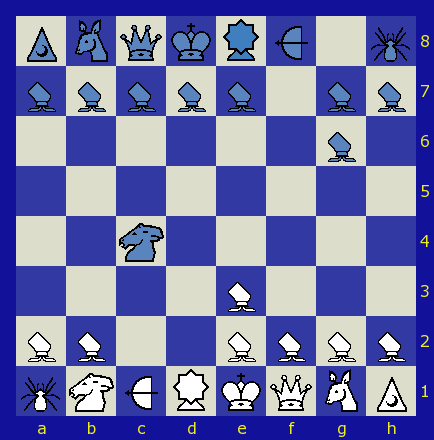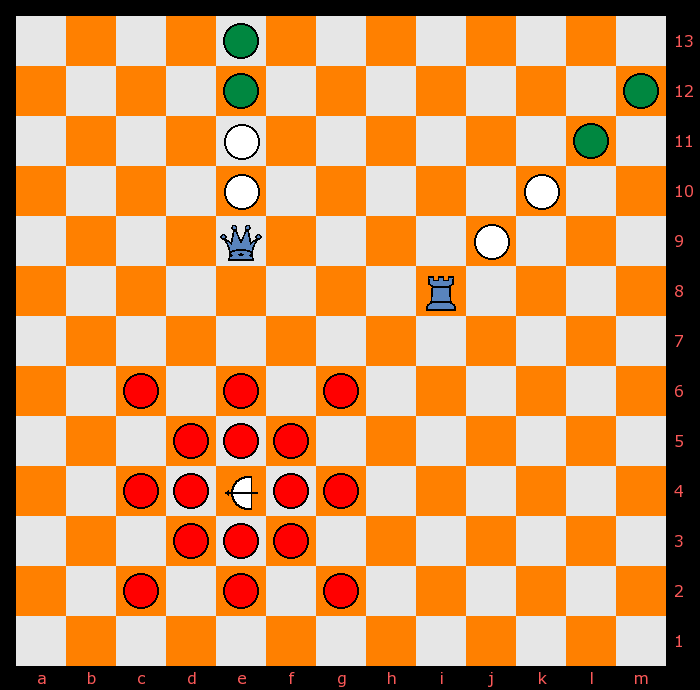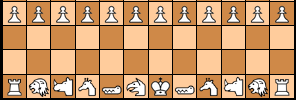Comments/Ratings for a Single Item
 Ben Reiniger wrote on Tue, Oct 14, 2014 04:02 AM UTC:
Ben Reiniger wrote on Tue, Oct 14, 2014 04:02 AM UTC:Yes, in the position cited, either of the the Cannon Pawns on a2 and e2 can act as spotters for Archer on c1 shoots Pushme-Pullyu on c3. No other friendly pieces can spot in this position. Suggestions of how to reword the rule to make this clearer are in order--as well as any other rewording: I plan to revise this page for clarity (no change in substance). Perhaps a general statement before the specific piece description such as "All pieces act on orthogonal or diagonal lines in any direction (though in some cases, limited by distance)." I'm also thinking it might make the capture rule clearer to phrase it in terms of all shots require a spotter, but if close enough, the Archer can spot for itself. Editors, which would be easier for you: to review submissions for revised pages, or to grant me editing rights to my own game pages--I am comfortable with either.
The Jeremy's last question, "In the current position of the game I cite, can the cannon pawns on e2 and a2 be seen as spotting the piece on c4?", has not been explicitly answered.
The current position cited is this:

The rule should reflect the real situation of an archer trying to hit the target when the victim is located at longer distances and needs help for focusing the shot, hence the role of the spotter.
The following diagram shows how I understand the matter.

 Red circles indicate all the possible short range captures.
Red circles indicate all the possible short range captures.
 White circles indicate the possible positions from which the spotter would fulfill its role.
White circles indicate the possible positions from which the spotter would fulfill its role.
 Green circles indicate positions from which any white piece [archer's friendly] would not fulfill the spotting role.
Green circles indicate positions from which any white piece [archer's friendly] would not fulfill the spotting role.
But this is only a personal interpretation and I'm, of course, willing to abide Michael's statement.
Thanks for your consideration. Okay, I think I mis-stated the real question in 2009. I think my friend and I agree that the spotter is the same side as the archer. If I understand correctly, the question is really where does the spotter have to be? * Behind the victim? (I think this is my friend's interpretation). * Or anywhere within two spaces in a straight line (diagonal or vertical or horizontal) from the victim? (My interpretation). In the current position of the game I cite, can the cannon pawns on e2 and a2 be seen as spotting the piece on c4?
I have no special knowledge of Fugue, but two considerations lead me to believe that the spotter must be on the same side as the Archer. First, the friendly piece is referred to in the paragraph on the Archer, so I infer the spotter is friendly to the Archer. Second, I interpret "spotting" as being like an artillery spotter, and logically, why would a piece spot another piece from its own side for an enemy Archer. Your friend sounds like a rules lawyer; he should relax, especially if this argument is five years old. Of course, you could play the game both ways and report back here which you fond to be better.
Fugue is example of a cv derived from another recent cv. It will be interesting to find more of these pair-inspired cvs one leading to another by different author within a year's time. Fugue of course comes out of earlier Rococo. Lavieri criticized numerical evaluation of cvs, http://www.chessvariants.org/index/displaycomment.php?commentid=5419, citing 23/47 as some arbitrary random number out of the blue (23/47 was not mentioned before but just Roberto's top of his head example). Immediately I realized 23/47 is not random at all, but the ratio of Queen to W. Amazon, http://www.chessvariants.org/index/displaycomment.php?commentid=5425. I still think Fugue simply has one, or maybe two, too many types.
'FOR LONGER SHOTS, some other friendly piece must spot the target by being ADJACENT to it or TWO squares away in an unobstructed STRAIGHT LINE.'
By 'some other friendly piece' do you mean friendly to the target or the archer?
 Joe Joyce wrote on Fri, Sep 22, 2006 03:49 AM UTC:Excellent ★★★★★
Joe Joyce wrote on Fri, Sep 22, 2006 03:49 AM UTC:Excellent ★★★★★The apparent ambiguity in the Roccoco rules for the Long Leaper were carried over into the rules for Fugue. Since the Fugue Long Leaper cannot make multiple captures, there is no need for the phrase 'jump over adjacent pieces' and I hereby remove it from the rules. (Could an editor make this change as soon as convenient?) In Fugue, a capture such as +--+--+--+--+--+ |LL| |p |p | x| +--+--+--+--+--+ is illegal as a multiple capture in any case, regardless of the ambiguous 'adjacent pieces', while +--+--+--+--+--+ |LL|p | | | x| +--+--+--+--+--+ is legal as in ultima and Rococco.
Michael: What happened with a PRESET in Courier for this nice game?. Can anybody help?
George, The Archer as it appears in Fugue is my creation and was not part of a collaboration. The Rococo variant thread discessed the merits or range 1 vs range 1 or 2 vs range 2 only Archers and whether special considerations should apply to attacking the King. No one before me said a word about an Archer that needed a spotter for long shots. I got the idea from artillery rules from some of Avalon Hill's war games, where certain units need a spotter to hit a target at beyong half range or in certain defensive positions. To my knowledge this concept has not been used in a Chess/Ultima variant before--I am open to correction if I err in this assertion.
George, You seem to be rather excessively critical of my game, considering that you rated it good and haven't played it. I don't design games by analytical design criteria and am not going to start doing so because you think I should. If you are certain that Fugue is a poor game because it has nine piece types on 64 sqaures, just say so and don't bother playing it or belaboring the point.
Roberto: In a way this topic starts with Robert Abbott's 1980's article 'What's Wrong with Ultima.' Eventually, tone of CVP becomes, what is right with Rococo?--Ultima offshoot. Now theme is: what is right and what is wrong with Fugue? I consider myself Rococo playing expert from present-Courier games, nothing wrong with Rococo as it is. Based on knowledge 2000 Encyclopedia CV games and more or less 2000 CVP games and 200 games patents more or less, I see at least one suspect feature in Fugue, high piece-type density, not having played it. Maybe standards or principles, Depth, Clarity, Piece-type Density, help evaluate games, because there is this prospect (simply using Fugue as available example): Vary the Archer-Bowman ten ways (ranges), vary the Shield ten ways (different piece combinations not shielded etc.), vary the Pawns ten ways (make one or two Pawns unique piece, for ten piece types altogether, etc.). Those options alone make 10x10x10 = 1000 new games, 1000 more sets of rules, more or less. A better way: a priori evaluative criteria. As far as subjectivity in Arts, Paracelsus says, 'Resolute imagination is the beginning of all magical operations. Because men do not perfectly believe and imagine, the result is that Arts are uncertain when they might be wholly certain.'
The last comment was mine. Excuse I forgot add my User ID. Yes, George, some measures may be very interesting, and it can show some things sometimes, but it is not all we can say about the theme. The rest of the message is going to be displayed in some moments, due my mistake.
George, I have yet to see a game of Fugue where 'one move is as good as another', excluding lost positions of course.
George, Your points have a fair amount of validity, but please consider that Fugue is an Ultima variant and should be judged as such--comparing it to Chess is not nearly so valid as comparing, for example, Tamerspiel to Chess. As for 'Because I like it . . .', ulimately this is the basis for every design decison I make. Any activity persued for fun rather than profit is subject to this criteria--and I've never known a CV inventor to get rich from his games. Now you make like a design decision because it conforms to design ideals that you believe in (and the ideals you list are good ones IMO), while my liking may be more subjective--but nevertheless, we are both submitting our decisions to the same final authority--our own respective tastes.
A general criticism of Fugue is the high number of piece types (nine) for its sixty-four squares, ratio 9/64. A much-commented game lately is Maxima with ratio piece types to squares 9/76, still (too) high, compared to Orthodox (Mad-Queen, FIDE) 6/64, RNBKQP. (Somewhat afield, at one time on CVP there were discussions of initial piece density where Orthodox shows 50%, as Fugue.) As further ex., in 84-square contest judging, my main critique of Tamerspiel is this same Piece-type Density, 20/84 there, twenty different types of pieces, confusing strategy. There is a point at which game piece differentiation distracts and detracts, players having to dwell on interpretations of rules before even considering actual moves; any chess-like game on 64 sqs. with say 16 different ways of moving surely fails. At some point, criteria like Drama, Decisiveness, Clarity and Depth, as in Mark Thompson's 'Defining the Abstract', need be used more systemically and justified than 'variantists' do today. Games developers justify choices with only 'I like this' or 'That works' without explanation. On what basis? By what other criteria than the five mentioned above?--I have five more to name for measure in another comment. Now Fugue is neat adaptation to 64-sqs.,worthy of its 'Excellents', retaining Cannon Pawns, Imm. and Swapper, the crux of Rococo, but the nine game piece forms may confound tactics, sort of leveling play where often one move is about good as another.
25 comments displayed
Permalink to the exact comments currently displayed.
